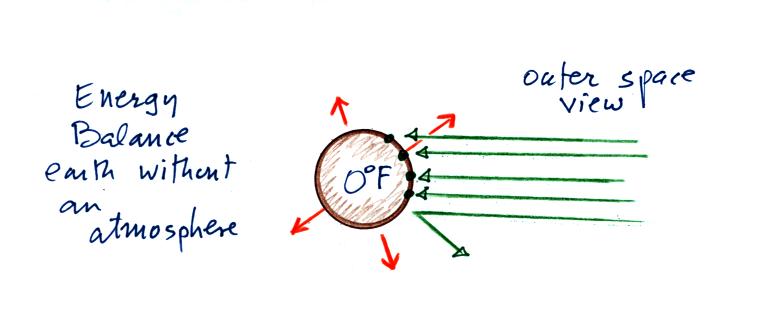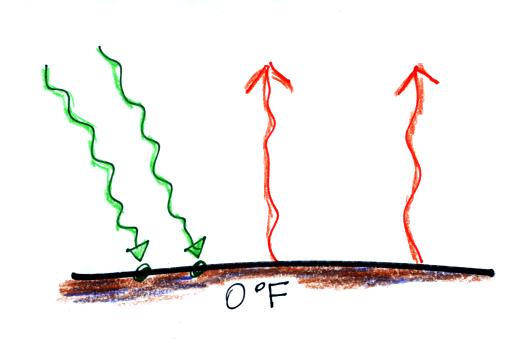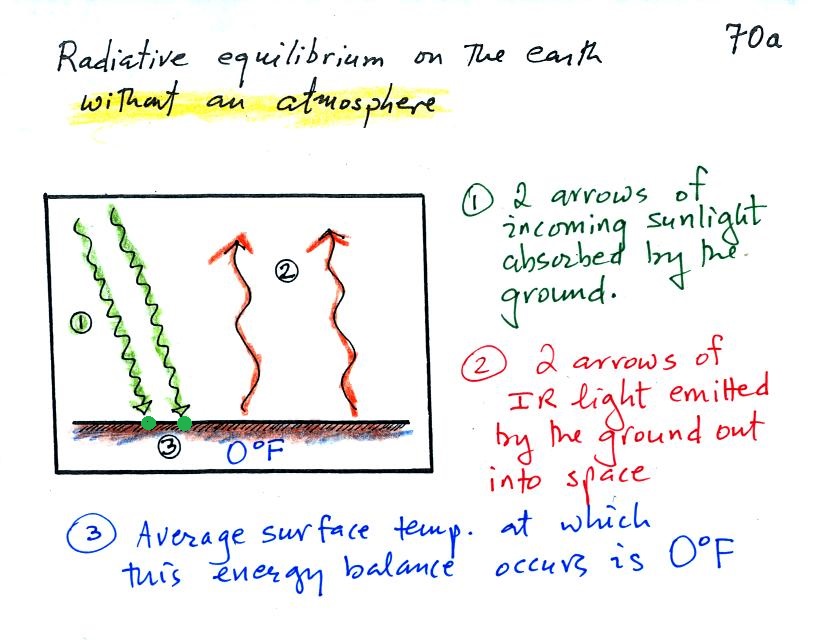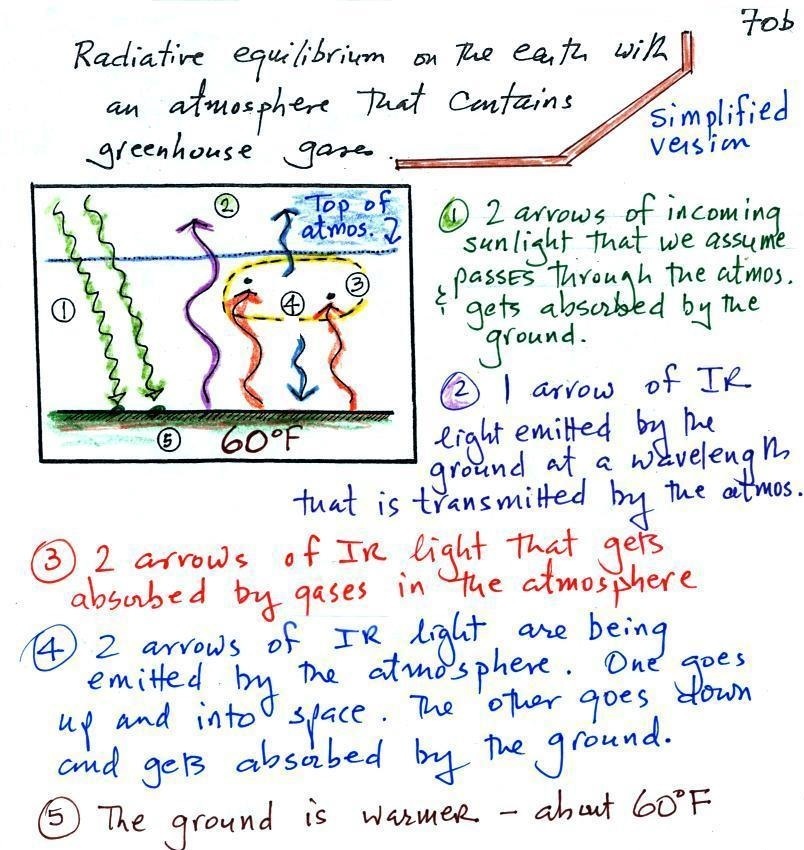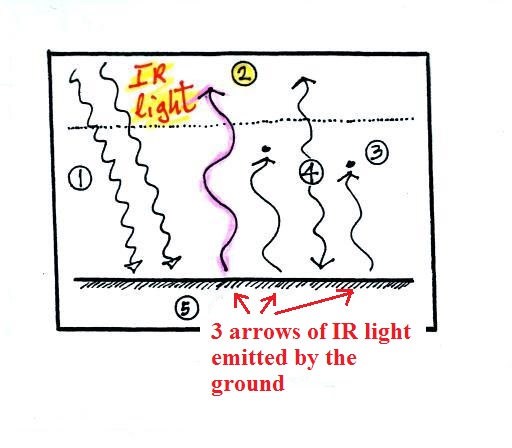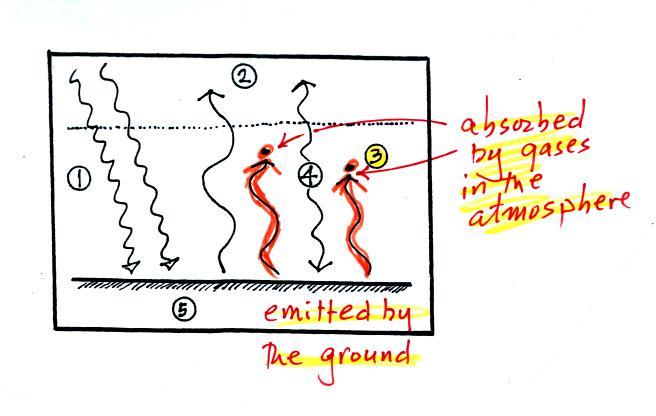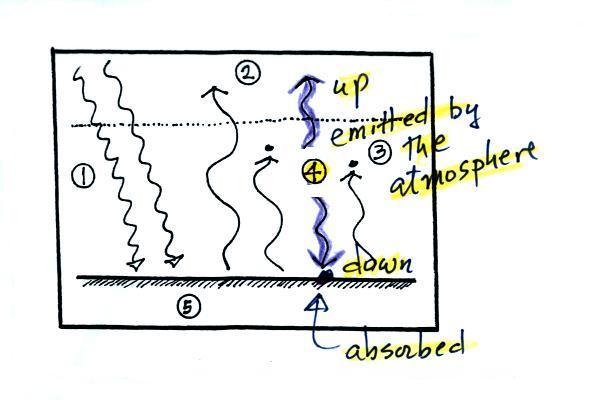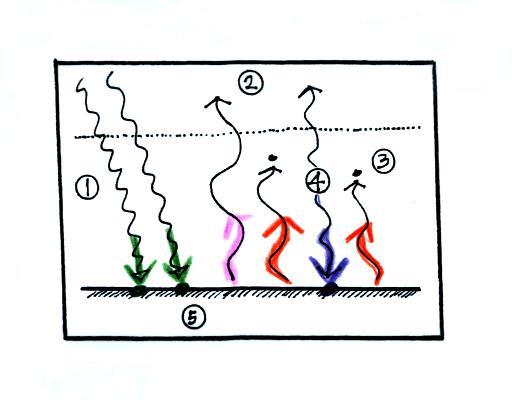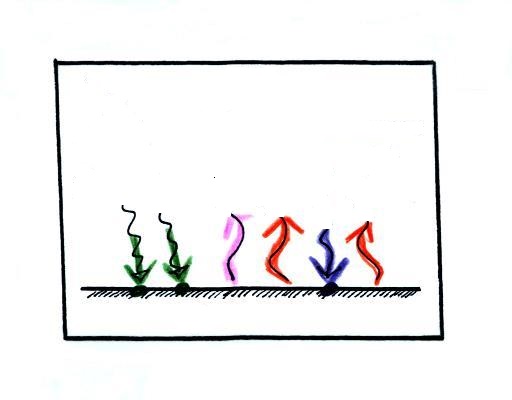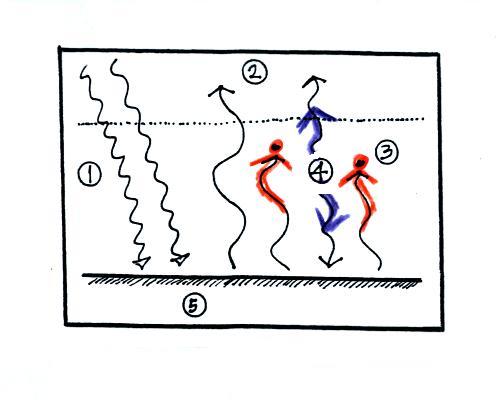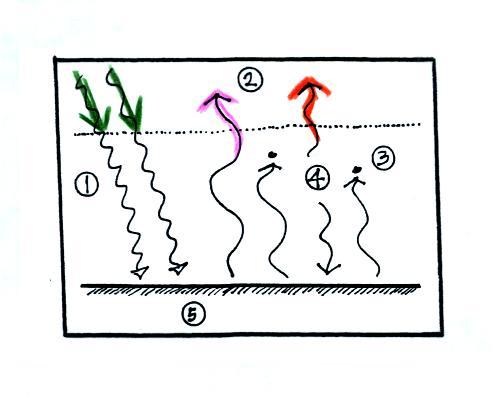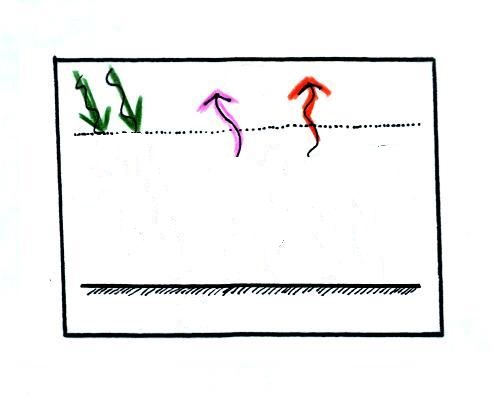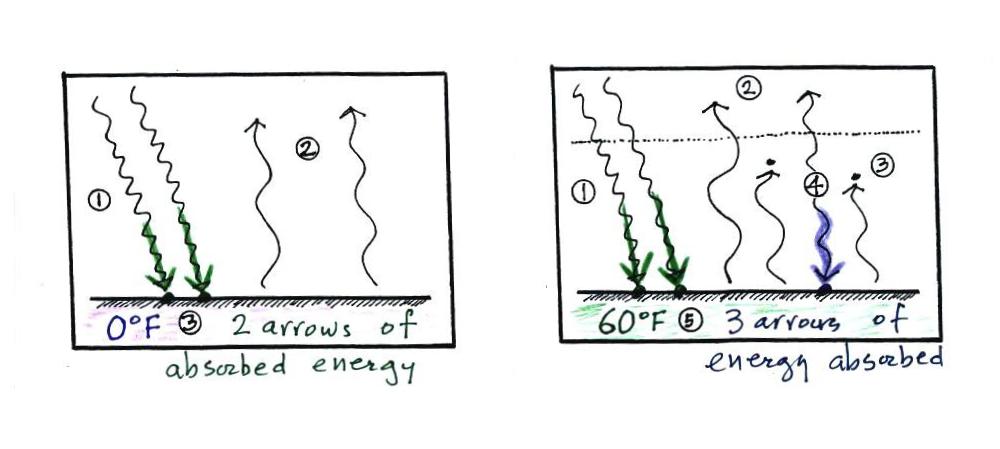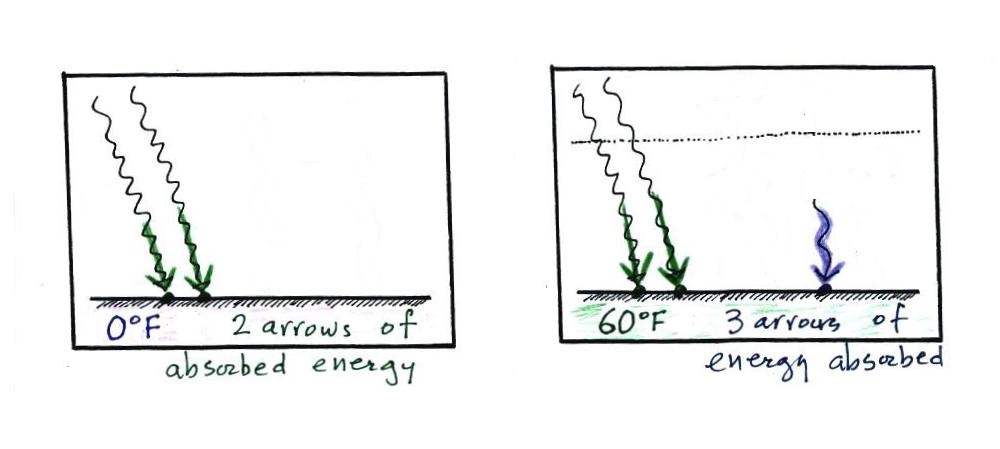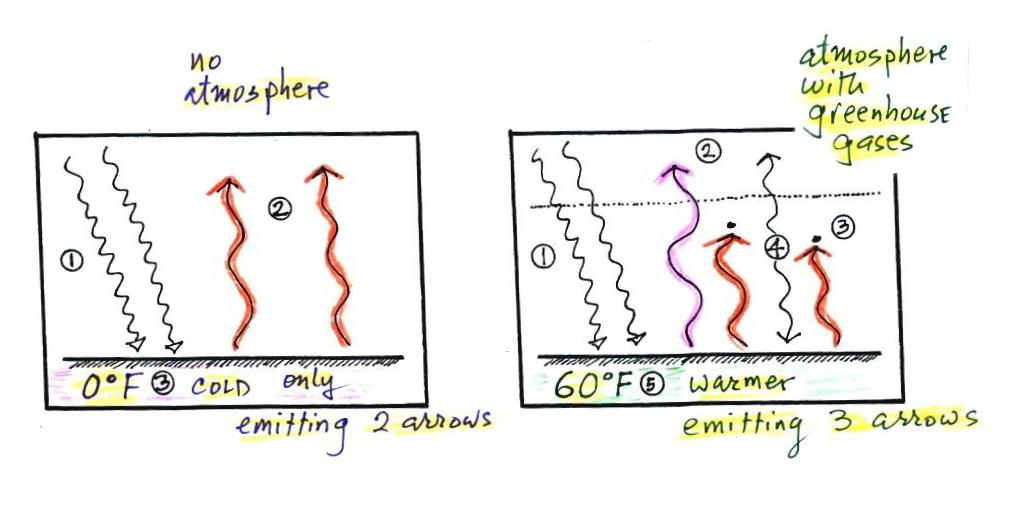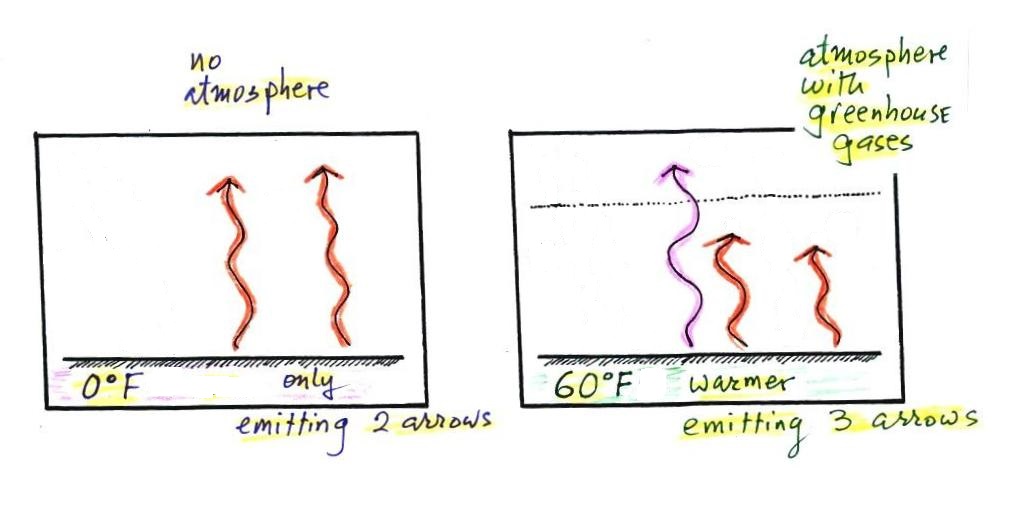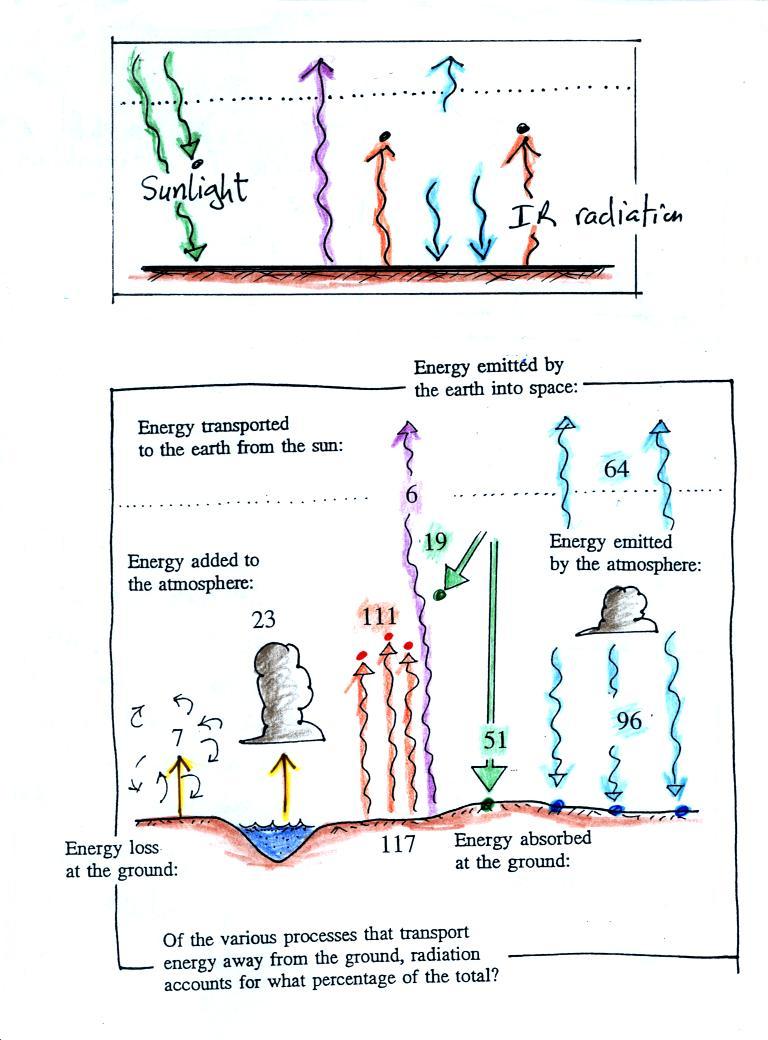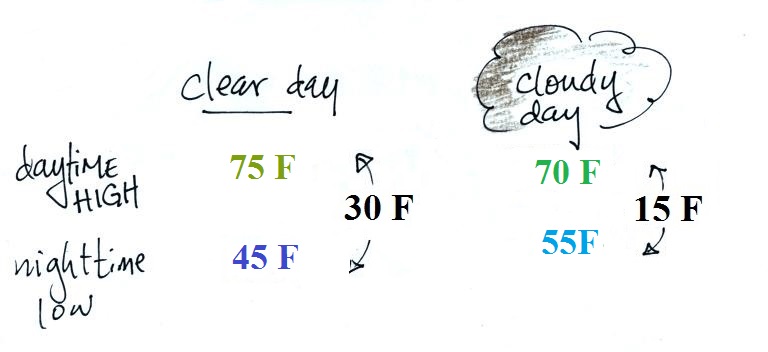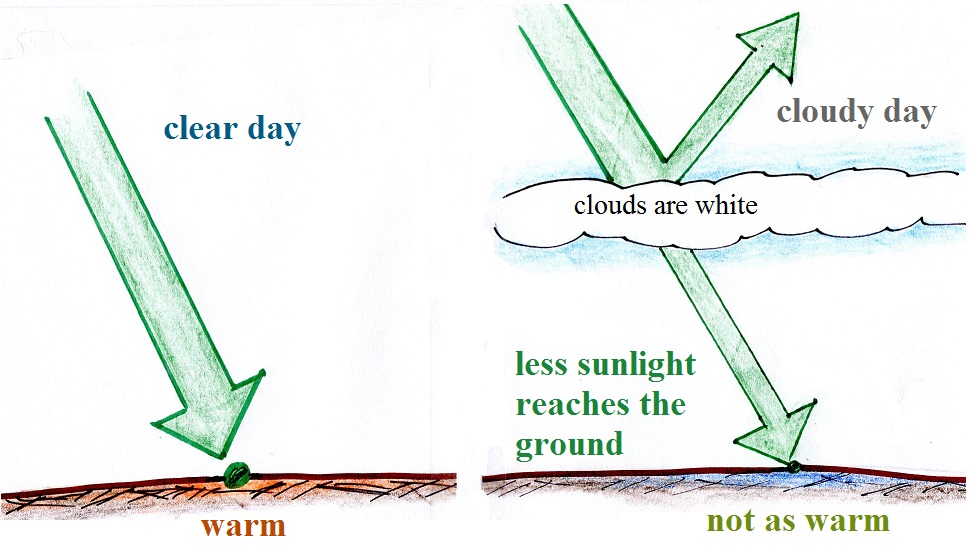Tuesday, Mar. 13, 2018
Alabama Shakes "Always
Alright" (4:19), "Future People"
(3:28), "I
Ain't the Same" (3:51), "Hang Loose"
(2:38), "Mama"
(2:46)
The Experiment #2 reports have been graded
and were returned in class today. Revised reports (if you
choose to do one, a revision of your report is not required) are
due in two weeks - by Tuesday, Mar. 27. Please return the
original report with your revised report.
The Experiment #1 revised reports have been graded and were
returned today.
The Surface Weather Map analyses (you could earn 1S1P or Extra
Credit pts) and the Upper Level Charts assignment (you could earn
Quiz #2 or Extra Credit pts) have both been graded.
I'm just getting started on the 1S1P Carbon Dioxide reports.
It will probably be a week or so before they are graded.
Quiz #2 is Thursday this week. See the Study Guide for more
information as well as the times and locations of the reviews.
There are several sets of Expt. #2 and Expt. #3 materials
available for checkout. Reports are due by Tue., Mar.
27. If you haven't done an experiment report yet I would
suggest you check out some of these materials. If you still
have some experiment materials that you checked out earlier in the
semester but never got around to doing the experiment, I would
encourage you to do the experiment and turn in a report by Mar.
27. It is not safe to assume that you will be allowed to
turn in a Scientific Paper or Book in lieu of an experiment.
I'm am trying to avoid having a large number of reports turned in
on the April 2 due date. We don't have a second Spring Break
between now and the end of the semester that will allow me to
catch up on grading.
The due date for the 1S1P Assignment #2b (Causes of the seasons or
The Equinoxes and Manhattanhenge) reports is Tuesday next week,
Mar. 20.
You'll find a two question In-class Optional Assignment embedded
in today's notes. If you weren't in class and would like to
do the assignment, you'll need to read through the notes below and
find the two questions. If you then turn in solutions at the
start of class on Wednesday you'll earn at least partial credit.
Filtering effect of the atmosphere on ultraviolet,
visible, and infrared light
The plan today is to look at radiative equilibrium (balance
between incoming and outgoing electromagnetic radiation) on the
earth with an atmosphere that contains greenhouse gases.
Before we do that we need to learn about how the atmosphere will
affect the incoming sunlight (a mixture of UV, visible, and
near IR light) and outgoing far IR light emitted by the
earth. We'll draw a filter absorption graph for the earth's
atmosphere.
Let's start with something simpler and something we can
see, the effects blue, green, and red glass filters have on
visible light. We'll be able to be sure we
understand what an absorption curve represents.

If you try to shine white light (a mixture
of all the colors) through a blue filter, only the blue light
passes through. The filter absorption curve shows 100%
absorption at all but a narrow range of wavelengths that
correspond to blue light. The location of the slot or
gap in the absorption curve shifts a little bit to the right
with the green and further right with the red filter.
The following figure is a simplified,
easier to remember representation of the filtering effect of
the atmosphere on UV, VIS, and IR light (found on p. 69 in the
photocopied notes).

1. You
can use your own eyes to tell you what effect the atmosphere
has on visible light. Air is clear, it is
transparent. The atmosphere transmits visible light.
2. In our simplified
representation oxygen and ozone make the atmosphere pretty
nearly completely opaque to UV light (opaque is the opposite
of transparent and means that light is blocked or absorbed;
light can't pass through an opaque material). We assume
that the atmosphere absorbs all incoming UV light, none of it
makes it to the ground. This is of course not entirely
realistic.
3. Greenhouse gases make the atmosphere a
selective absorber of IR light - the air absorbs certain IR
wavelengths and transmits others .
Wavelengths between 0.7 and 8 or 9 μm
are absorbed (by greenhouse gases), radiation centered at 10μm
is transmitted by the atmosphere. Wavelengths greater
than 10 μm are absorbed
(again by greenhouse gases). The atmosphere also emits
IR radiation. It is the atmosphere's ability
to absorb certain wavelengths of infrared light and emit
infrared light that produces the greenhouse effect and warms
the surface of the earth.
Note "the atmospheric window" centered at 10 micrometers. Light emitted by
the earth at this wavelength (and remember 10 um is the
wavelength of peak emission for the earth) will pass through
the atmosphere. Another transparent region, another
window, is found in the visible part of the spectrum.
Back to radiative equilibrium on the earth
without an atmosphere
We'll return to our earlier picture of radiative equilibrium
here's the view from space
The important thing to note is that the earth is absorbing and
emitting the same amount of energy (4 arrows absorbed balanced by
4 arrows emitted). We've ignored the one arrow of reflected
sunlight.
and now radiative equilibrium
viewed from the ground
Don't let the fact that there are 4 arrows are being
absorbed and emitted in one figure and 2 arrows absorbed and
emitted in the other bother you. The important
thing is that there are equal amounts being absorbed and emitted
in both cases.The reason for only using two arrows in
this picture is to keep the picture as simple as possible.
It will get complicated enough when we add the atmosphere to the
picture.
Here's basically the same
picture, this is the one that is in the ClassNotes (p.
70a). There's a little explanation added.
Radiative equilibrium on the earth with an atmosphere
- the greenhouse effect
The next step is to add the atmosphere.
We will study a
simplified version of radiative equilibrium just so
you can identify and understand the various parts of the
picture. Keep an eye out for the greenhouse
effect. Here's a cleaned up version of what we
ended up with in class. Energy balance is a little more
complex in this case, there are more arrows to sort out.
It would be hard to sort through and try
to understand all of this if you weren't in class (difficult
enough even if you were in class). So below we will go
through it again step by step (which you are free to skip
over if you wish). Caution: some of the colors
below may be different from those used in class.
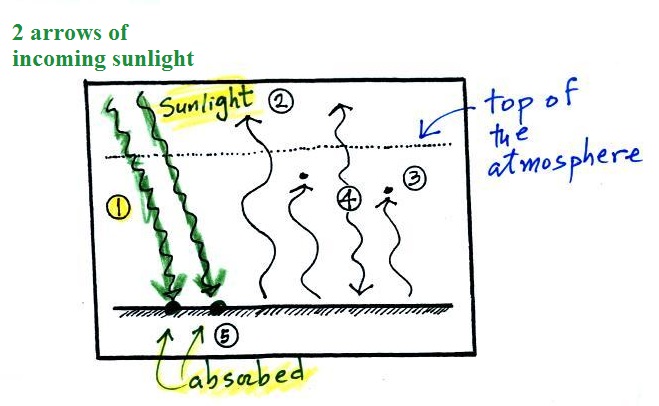
1. In
this picture we see the two rays of incoming sunlight that
pass through the atmosphere, reach the ground, and are
absorbed. 100% of the incoming sunlight is
transmitted by the atmosphere. This wouldn't be too
bad of an assumption if sunlight were just visible
light. But it is not, sunlight is about half IR
light and some of that is going to be absorbed. But
we won't worry about that at this point.
The ground is emitting
a total of 3 arrows of IR radiation. That might seem
like a problem. How can the earth emit 3 arrows when
it is absorbing only 2 from the sun. We'll see how
this can happen in a second.
2. One
of
these
(the
pink
or
purple
arrow
above)
is
emitted
by
the
ground
at
a
wavelength
that
is
not absorbed
by greenhouse gases in the atmosphere (probably around 10
micrometers, in the center of the "atmospheric
window"). This radiation passes through the atmosphere
and goes out into space.
3. The other 2 units of IR radiation emitted
by the ground are absorbed by
greenhouse gases is the atmosphere.
4.
The atmosphere is absorbing 2 units of radiation.
In order to be in radiative equilibrium, the atmosphere must
also emit 2 units of radiation. That's shown
above. 1 unit of IR radiation is sent upward into
space, 1 unit is sent downward to the ground where it is
absorbed. This is probably
the part of the picture that most students have the most
trouble visualizing (it isn't so much that
they have trouble understanding that the atmosphere emits
radiation but that 1 arrow is emitted upward and another is
emitted downward toward the ground). Both arrows leave
the atmosphere, one goes out into space and the other goes
into the ground.
Now that all the arrows are accounted for, we will check to be
sure that every part of this picture is in energy balance.
Checking for energy balance
at the ground.
It might help to cover up all but the
bottom part of the picture with a blank sheet of paper
(that's what I tried to do in the right figure below).
The ground is absorbing 3 units
of energy (2 green arrows of sunlight and one blue arrow
coming from the atmosphere) and emitting 3 units of energy
(one pink and two red arrows). The ground is
in energy balance. The earth
emits more energy (3 units) than it gets from the sun (2
units). It can do this because it gets energy from the
atmosphere.
Checking for energy balance in the
atmosphere
The atmosphere is absorbing 2 units of energy (the
2 red arrows coming from the ground) and emitting 2 units of
energy (the 2 blue arrows). One goes upward into
space. The downward arrow goes all the way to the ground
where it gets absorbed (it leaves the atmosphere and gets
absorbed by the ground). We don't care where the arrows
are coming from or where they are going. We are just
interested in the amounts of energy gained and lost by the
atmosphere. The atmosphere is in energy balance.
And we should check to be sure equal amounts
of energy are arriving and leaving at the top of the
atmosphere
2 units of energy arrive at the
top of the atmosphere (green) from the sun after traveling
through space, 2 units of energy (pink and orange) leave
the earth and head back out into space. Energy
balance here too.
Did you spot the greenhouse effect?
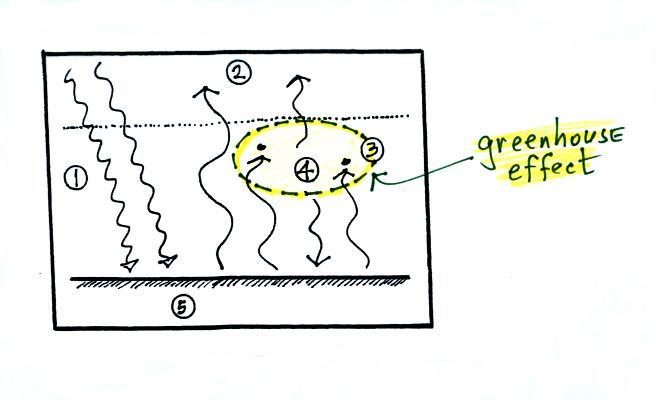
It's Points 3 &
4 in the figure. The greenhouse effect depends on both
absorbing IR radiation and emitting IR
radiation. Here's how you might put it into
words.
We didn't cover the following section in class today.
The greenhouse effect warms the earth's surface.
The global annual average surface temperature is about 60 F on the
earth with a greenhouse effect. It would be about 0 F
without the greenhouse effect.
Here are a couple other ways of understanding why/how this
warming occurs.
The
picture at left is the earth without an atmosphere
(without a greenhouse effect). At right the earth
has an atmosphere, one that contains greenhouse
gases.
Here we have removed all but the
energy arriving at the ground. At left the ground
is getting 2 units of energy (from the sun). At
right it is getting three, two from the sun and one from
the atmosphere (thanks to the greenhouse effect).
Doesn't it seem reasonable that ground that absorbs 3
units of energy will end up warmer than ground that is
only absorbing 2?
The next picture shows an even better (but more subtle) way of
analyzing the situation.
And again we'll simplify the picture by removing
all but the emitted energy.
To be in energy balance, the ground in the picture above at
left must emit 2 arrows of radiant energy.
At right the ground has to somehow send 2 units of IR energy
back into space. The ground "knows" that some of what it
emits will be returned to the ground (some of what the ground
emits is absorbed by the atmosphere and sent (emitted) back to
the ground because of the greenhouse effect). So the
ground emits a "little extra" (3 units) so that 2 units can
escape into space.
The amount of energy emitted by an object depends on
temperature (to the 4th power). The Stefan-Boltzmann
laws tell us that. So to be able to emit 3 units of IR
energy the ground has to be warmer than if it only has to emit
2 units of energy.
How much of the sunlight arriving at the top of the
atmosphere actually makes it to the ground?
In the simplified explanation of the greenhouse
effect last week we assumed that 100% of the sunlight arriving
at the top of the earth's atmosphere passed through the
atmosphere and got absorbed at the ground. That would be a
reasonable assumption if sunlight were just visible light, but
it's not. We will get a better idea of what happens to
the incoming sunlight.

The bottom figure above shows that on average (averaged over
the year and over the globe) about half (50%)
of the incoming sunlight makes it through the atmosphere and
gets absorbed at the ground. This is the only number in
the figure you should try to remember.
About 20% of the incoming sunlight is absorbed by gases in the
atmosphere. Sunlight is a mixture of mostly visible and near
IR light. There are smaller amounts of far IR and UV
light. Ozone and oxygen will absorb most of the UV (UV makes
up only 7% of sunlight). Roughly half (49%) of sunlight is
IR light and greenhouse gases will absorb some of that.
The remaining 30% of the incoming sunlight is reflected or
scattered back into space (by the ground, clouds, even air
molecules).
Expt. #3 students take note.
The object of Expt. #3 is to measure the
energy in the sunlight arriving at the ground here in
Tucson. About 2 calories of sunlight energy pass through a
one square centimeter area every minute at the top of the
atmosphere. Since about 50% of that will reach the ground,
you should get a value of about 1 calorie/(cm2
min).

|

|
Here is our simplified
version of the greenhouse effect
from earlier in the day. This figure is in energy
balance
|
This is a
more realistic representation because it allows only
half of the incoming sunlight to reach the
ground. The other half is absorbed by the
atmosphere.
|
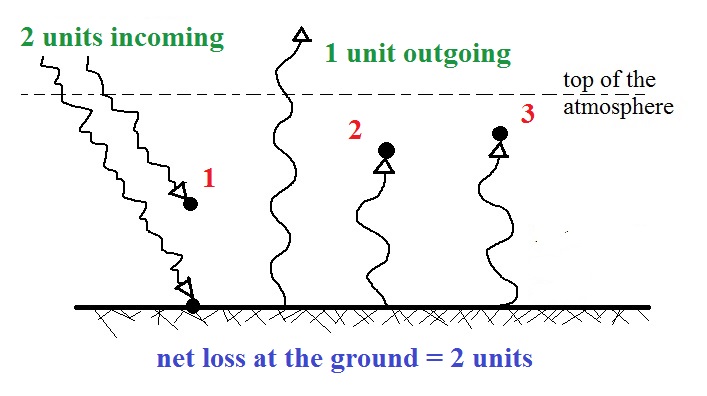 |

|
As shown here the figure is incomplete
and is not in energy balance.
The atmosphere is absorbing 3 units of energy but not
emitting any.
We need to add 3 arrows of emitted energy. The
question is what direction
to send them, up or down. This was the first part of
an Optional In-class Assignment.
The ground is emitting 3 units of energy and getting 1
from the sun. It needs two additional units to be in
energy balance. At the top of the picture we need 1
more unit of outgoing energy. |
We send 1 of the 3 units of energy
emitted by the atmosphere upward. We send the two
remaining units downward. Now all three parts of the
figure are in energy balance.
Here's the solution to the problem of bringing the
figure into energy balance.
|

|
Here's another
example to try to balance on your own. This
was the 2nd question on the In-class Assignment.
You'll find the answer at the end of today's notes
|
A more realistic picture of energy balance on the earth
The top part of the figure below is our new and improved but
still simplified representation of energy balance and the
greenhouse effect.
In the top figure you should recognize the incoming
sunlight (green), IR emitted by the ground that passes through the
atmosphere (violet), IR radiation emitted by the ground that is
absorbed by greenhouse gases in the atmosphere (orange) and IR
radiation emitted by the atmosphere (blue).
The lower part of the figure is pretty complicated. It would
be difficult to start with this figure and find the greenhouse
effect in it. That's why we used a simplified version.
Once you understand the upper figure, you should be able to find
and understand the corresponding parts in the lower figure (I've
tried to use the same colors for each of the corresponding parts).
The figure assumes that 100 units of sunlight energy are
arriving at the top of the atmosphere. About half of the
incoming sunlight (51 units in green, we rounded that down to 50
in an earlier figure) reaches the ground and is absorbed. 19
units of sunlight (we rounded that up to 20 in the earlier figure)
are absorbed by gases in the atmosphere. The 30 units of
reflected sunlight weren't included in the figure.
The ground emits a total of 117 units of IR light. Only 6
shine through the atmosphere and go into space. The
remaining 111 units are absorbed by greenhouse gases.
There were 3 somewhat surprising things to
notice in the figure.
(1). How can the
ground be emitting more energy (117 units) than it gets from
the sun (51 units ) and still be in energy balance?
The answer is that the ground isn't just receiving sunlight
energy. It is also getting energy from the atmosphere.
That's thanks to the greenhouse effect. Most of the energy
emitted by the ground is absorbed by greenhouse gases in the
atmosphere. The atmosphere then emits some of this energy
downwards. The ground gets back some of what it would
otherwise have lost.
If you're really paying attention you would notice that 117 units
emitted doesn't balance 96 + 51 = 147 units absorbed. The
surface is emitting 117 units but an additional 30 units are being
carried from the ground to the atmosphere by conduction,
convection, and latent heat (at the far left of the figure).
That brings everything into balance (117 + 30 = 147). Note
how much smaller the energy transport by conduction, convection,
and latent heat are compared to radiant energy transport.
(2).
Why are the amounts of energy emitted upward (64
units) and downward (96 units) different?
One reason might be that the lower atmosphere is warmer than the
upper atmosphere (warm objects emit more energy than cold
objects). But I think a better explanation is that there is
more air in the bottom of the atmosphere (the air is denser) than
near the top of the atmosphere. It is the air in the
atmosphere that is emitting radiation. More air = more
emission.
Note that the atmosphere is emitting more energy downward than
upward in our simplified version of the greenhouse effect.
(3).
The ground is receiving more energy from the
atmosphere (96 units) than it gets from the sun (51 units)!
Doesn't that seem surprising? I think the main reason for
this is that the sun just shines for part of the day (half the day
on average over the course of a year). We receive energy
from the atmosphere 24 hours per day, 365 days per year.
We didn't cover this
section and the one after it in class.
A common misconception about the cause of global warming.
Many people know that sunlight contains UV light and that the
ozone layer absorbs much of this dangerous type of high energy
radiation. People also know that release of chemicals such
as CFCs are destroying stratospheric ozone and letting some of
this UV light reach the ground. That is all correct.
But then they conclude that it is this additional UV energy
reaching the ground that is causing the globe to warm. This is not correct.
There isn't enough additional UV light to cause significant
warming. The additional UV light will cause cataracts and
skin cancer and those kinds of problems but not global warming.
If all 7% of the UV light in sunlight were to reach the ground
it probably would cause some warming. But it probably
wouldn't matter because some of the shortest wavelength and most
energetic forms of UV light would probably kill us and most other
forms of life on earth. We wouldn't be around long enough to
have to worry about climate change. Ultraviolet Light is the
subject of one of the new 1S1P
Report topics.
Enhancement of the greenhouse effect and global warming
Here's the real cause of global warming and the reason for
concern (this is also the last time you'll see these
energy balance pictures)

The figure (p. 72b in the photocopied Class Notes) on the left
shows energy balance on the earth without an atmosphere (or
with an atmosphere that doesn't contain greenhouse
gases). The ground achieves energy balance by emitting
only 2 units of energy to balance out what it is getting from
the sun. The ground wouldn't need to be very warm to do
this, only 0 F.
If you add an atmosphere and greenhouse gases, the
atmosphere will begin to absorb some of the outgoing IR
radiation. The atmosphere will also begin to emit IR
radiation, upward into space and downward toward the
ground. After a period of adjustment you end up with a
new energy balance. The ground is warmer and is now
emitting 3 units of energy even though it is only getting 2
units from the sun. It can do this because it gets a
unit of energy from the atmosphere. This is what I refer
to as the beneficial greenhouse effect. It makes the
earth more habitable by raising the average surface
temperature to 60 F.
In the right figure the concentration of greenhouse gases
has increased even more (due to human activities). The
earth might find a new energy balance. In this case the
ground would be warmer and could be emitting 4 units of
energy, but still only getting 2 units from the sun.
With more greenhouse gases, the atmosphere is now able to
absorb 3 units of the IR emitted by the ground. The
atmosphere sends 2 back to the ground and 1 up into
space. A new balance is achieved but the earth's surface
is warmer. How much warmer? That's the big
question. An even bigger question is what effects that
warming will have.
Don't worry about all the details in this figure, just notice
the trend. As greenhouse gas concentrations increase,
the earth warms.
The effects of clouds on daytime high and nighttime low
temperatures
This is a topic that I often "beat to death." I want to
keep it as short and simple as I can this semester.
Here are some pretty typical high and low temperatures for this
time of year in Tucson. Notice the effects that clouds have:
they generally lower the daytime high temperature (it doesn't get
quite as hot on a cloudy day as it would on a clear day) and raise
the nighttime low temperature (it doesn't get quite as cold on a
cloudy night as it would on a clear night).
Sunlight is what warms the earth during the day. Sunlight is
mostly visible and near-IR light. Clouds are good reflectors
of visible and near IR light (clouds appear white). A
smaller fraction of the incoming sunlight will reach the ground on
a cloudy and it won't get as warm.
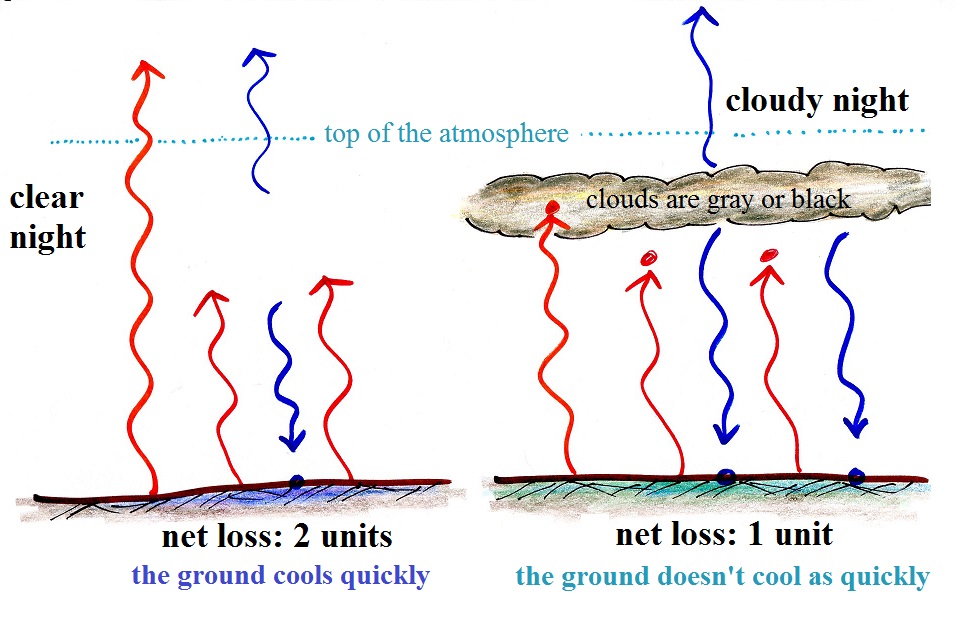
The situation is different at night. The sun is no longer
in the picture. The ground cools by emitting far-IR
light. Without an atmosphere at all this IR energy would
travel out to space and the ground would cool very quickly and get
very cold. Greenhouse gases absorb some of this IR light
emitted by the ground and re emit a portion of it back to the
ground.
It turns out that clouds are good absorbers of far-IR light too
(they absorb some of the wavelengths that greenhouse gases do
not). I've colored the cloud layer grey in the right picture
above. If our eyes were sensitive to far IR instead of
visible clouds would appear gray or black. I've also added
some orange to the gray cloud because clouds also emit far IR
light. Some of this emitted IR light is downward to
the ground and reduces the rate at which the ground cools.
It doesn't get as cold on a cloudy night as it would on a clear
night.
Here's the answer to the 2nd question on the In-class Optional
Assignment.

|
The atmosphere
is absorbing two units of energy so it needs to also emit
2 units. We'll send 1 upward and 1 downward.
At the top of the picture we now have equal amounts of
incoming and outgoing energy. Down at the ground the
1 unit being emitted is balanced by 1 unit of absorbed
energy.
|



